Simplified Method for Nonlinear Seismic Response Analysis of Corroded Pile-Supported Wharf
Abstract
:1. Introduction
2. Methods
2.1. Model Geometry and Material Properties
2.2. Corrosion Effect on the Spun Pile Materials
2.3. Fiber-Based Finite Element Analysis
2.4. Frame Analysis
2.5. Pushover Analysis
- (1)
- Determining the reduction in PC bar area due to corrosion over 75 years. The corrosion degree was determined for each elapsed year.
- (2)
- Developing mechanical properties of PSWs with corroded spun piles.
- (3)
- Constructing PSW models based on the step (2) results. FB-FEA models considered the stress–strain curve of the corroded spun pile materials combined with the corroded PC bar area reduction resulting from step (1). Furthermore, FA-1 and FA-2 models considered the reduced PC bar area, deteriorated concrete compressive strength of the corroded spun pile, and reduced PC bar yield strength.
- (4)
- Defining the hinge properties and bending stiffness reduction factor of corroded spun piles in FA-1 and FA-2 models. Setting the hinge properties of corroded spun piles consists of defining the moment–curvature relationship and determining the axial force-bending moment capacity of corroded spun piles. In FA-1, the definition of the moment–curvature relationship and bending stiffness reduction factor of corroded spun piles were referred to existing methods [3,32]. Whereas in FA-2, the moment–curvature relationship and bending stiffness reduction factor of corroded spun piles were proposed based on ACI 318 [55] and the PCI Design Handbook [56].
- (5)
- Performing pushover analysis at different corrosion degrees.
- (6)
- Observing the nonlinear seismic response of corroded PSWs obtained from the pushover analysis results and comparing the results of the three methods in terms of natural period, inertial force, plastic hinges formation, and load capacity of corroded PSWs.
3. Results and Discussion
3.1. Bending Stiffness Reduction Factor of Corroded Spun Pile
3.2. P-M Capacity Curves
3.3. Plastic Hinges Formation
3.4. Pushover Curves
4. Conclusions
- The results obtained with FA-2 are in excellent agreement with the FB-FEA results for the nonlinear seismic response of corroded PSWs in terms of the natural period, plastic hinge formation, and load capacity. The proposed method for defining the moment–curvature relationship, P-M capacity, and bending stiffness reduction factor for corroded spun piles has been introduced and applied to FA-2, resulting in differences for the natural period and load capacity of corroded PSWs that are no more than 0.35% and 0.44%, respectively, compared to the FB-FEA results. The FB-FEA itself has also been extensively validated for its ability to reproduce experimental results.
- The FA-1 results for the P–M capacity and plastic hinge formation are the same as the FB-FEA and FA-2 results. However, FA-1 determines the bending stiffness reduction factor and moment–curvature relationship of corroded spun piles based on the results of previous studies and produces significantly different results for the natural periods and load capacities of corroded PSWs compared to the FB-FEA results. The maximum differences in the FA-1 results for the natural period and load capacity of a corroded PSW compared to the FB-FEA results were 15.96% and 12.66%, respectively.
- The pushover curves of corroded PSWs obtained from FB-FEA differ from those obtained from the FA models. The 2D PSW model with distributed plasticity (FB-FEA) produces smoother, more precise pushover curves than the FA model with an idealized plasticity approach (concentrated hinge). However, by properly defining the bending stiffness reduction factor, moment–curvature relationship, and P–M capacity of the corroded spun piles, the FA-2 method can predict load capacities with similar accuracy as FB-FEA.
- Corrosion has more adverse effects on the compressive axial load and bending moment capacities of spun piles than tensile axial load capacity. In this study, at a corrosion degree of 18.56%, the maximum reductions in compressive axial load capacity and bending moment capacity were 60.84% and 48.42%, respectively. In contrast, the maximum reduction in tensile axial load capacity was only 13.26%.
Author Contributions
Funding
Institutional Review Board Statement
Informed Consent Statement
Data Availability Statement
Acknowledgments
Conflicts of Interest
References
- Yulius; Prakoso, W.A.; Orientilize, M.; Sentosa, B.O.B. Numerical Study of Spun Pile to Pile Cap Connections in Soft Soil. J. Phys. Conf. Ser. 2021, 1858, 012087. [Google Scholar] [CrossRef]
- Liang, F.; Zhang, H.; Wang, J. Variational Solution for the Effect of Vertical Load on the Lateral Response of Offshore Piles. Ocean Eng. 2015, 99, 23–33. [Google Scholar] [CrossRef]
- Shao, W.; Shi, D.; Jiang, J.; Chen, Y. Time-Dependent Lateral Bearing Behaviour of Corrosion-Damaged RC Pipe Piles in Marine Environments. Constr. Build. Mater. 2017, 157, 676–684. [Google Scholar] [CrossRef]
- Poursaee, A.; Ross, B. The Role of Cracks in Chloride-Induced Corrosion of Carbon Steel in Concrete—Review. Corros. Mater. Degrad. 2022, 3, 258–269. [Google Scholar] [CrossRef]
- Yin, P.; Wang, K.; Chen, L.; Zhang, Y.; Yang, K.; Wang, J. Horizontal Bearing Capacity and Reliability of Piles in Coastal Soft Soil Considering the Time-Varying Characteristics. J. Mar. Sci. Eng. 2023, 11, 247. [Google Scholar] [CrossRef]
- International Navigation Association. Seismic Design Guidelines for Port Structures; Swets & Zeitlinger B.V.: Lisse, The Netherlands, 2001; ISBN 90 265 1818 8. [Google Scholar]
- The Overseas Coastal Area Development Institute of Japan. Technical Standards and Commentaries for Port and Harbour Facilities in Japan; Ports and Harbours Bureau, Ministry of Land, Infrastructure, Transport and Tourism (MLIT): Tokyo, Japan, 2020. [Google Scholar]
- Zacchei, E.; Lyra, P.H.C.; Stucchi, F.R. Nonlinear Static Analysis of a Pile-Supported Wharf. Rev. Ibracon Estrut. Mater. 2019, 12, 998–1009. [Google Scholar] [CrossRef]
- Leonhardt, F. Cracks and Crack Control in Concrete Structures. PCI J. 1988, 33, 124–145. [Google Scholar] [CrossRef]
- Chiaramonte, M.M.; Arduino, P.; Lehman, D.E.; Roeder, C.W. Seismic Analyses of Conventional and Improved Marginal Wharves. Earthq. Eng. Struct. Dyn. 2013, 42, 1435–1450. [Google Scholar] [CrossRef]
- Su, L.; Wan, H.P.; Lu, J.; Ling, X.; Elgamal, A.; Arulmoli, A.K. Seismic Performance Evaluation of a Pile-Supported Wharf System at Two Seismic Hazard Levels. Ocean Eng. 2021, 219, 108333. [Google Scholar] [CrossRef]
- Setiawan, A.F.; Darmawan, M.F.; Ismanti, S.; Sunarso, M.; Adityawarman, G.M. Numerical Model for Investigating Seismic Performance of Prestressed Hollow Concrete (PHC) Piles with Fiber Section Element. E3S Web Conf. 2020, 156, 3007. [Google Scholar] [CrossRef]
- Shafieezadeh, A.; DesRoches, R.; Rix, G.J.; Werner, S.D. Seismic Performance of Pile-Supported Wharf Structures Considering Soil-Structure Interaction in Liquefied Soil. Earthq. Spectra. 2012, 28, 729–757. [Google Scholar] [CrossRef]
- Kolozvari, K.; Orakcal, K.; Wallace, J.W. New Opensees Models for Simulating Nonlinear Flexural and Coupled Shear-Flexural Behavior of RC Walls and Columns. Comput. Struct. 2018, 196, 246–262. [Google Scholar] [CrossRef]
- Kashani, M.M.; Lowes, L.N.; Crewe, A.J.; Alexander, N.A. Computational Modelling Strategies for Nonlinear Response Prediction of Corroded Circular RC Bridge Piers. Adv. Mater. Sci. Eng. 2016, 2016, 2738265. [Google Scholar] [CrossRef]
- Feng, D.C.; Xiong, C.Z.; Brunesi, E.; Parisi, F.; Wu, G. Numerical Simulation and Parametric Analysis of Precast Concrete Beam-Slab Assembly Based on Layered Shell Elements. Buildings 2021, 11, 7. [Google Scholar] [CrossRef]
- Perea, T.; Leon, R.T. Composite Beam-Columns Performance Based on Nonlinear Fiber and Finite Element Analysis. In Proceedings of the World Conference on Earthquake Engineering (WCEE), Beijing, China, 12–17 October 2008. [Google Scholar]
- Schmuhl, D.T.; Loos, S.; Hur, J.; Shafieezadeh, A. Time-Dependent Probabilistic Capacity Degradation Assessment of Prestressed Concrete Piles in Marine Environment. Struct. Infrastruct. Eng. 2018, 14, 1372–1385. [Google Scholar] [CrossRef]
- Mirzaeefard, H.; Hariri-Ardebili, M.A.; Mirtaheri, M. Time-Dependent Seismic Fragility Analysis of Corroded Pile-Supported Wharves with Updating Limit States. Soil Dyn. Earthq. Eng. 2021, 142, 106551. [Google Scholar] [CrossRef]
- McKenna, F. OpenSees: A Framework for Earthquake Engineering Simulation. Comput. Sci. Eng. 2011, 13, 58–66. [Google Scholar] [CrossRef]
- Chiou, J.-S.; Yang, H.-H.; Chen, C.-H. Use of Plastic Hinge Model in Nonlinear Pushover Analysis of a Pile. J. Geotech. Geoenviron. Eng. 2009, 135, 1341–1346. [Google Scholar] [CrossRef]
- Wani, F.M.; Vemuri, J.; Rajaram, C.; Babu R, D.V. Effect of Soil Structure Interaction on the Dynamic Response of Reinforced Concrete Structures. Nat. Hazards Res. 2022, 2, 304–315. [Google Scholar] [CrossRef]
- Wu, W.; Zhang, Y. A Review of Pile Foundations in Viscoelastic Medium: Dynamic Analysis and Wave Propagation Modeling. Energies 2022, 15, 9432. [Google Scholar] [CrossRef]
- Wu, W.; Lu, C.; Chen, L.; Mei, G.; El Naggar, M.H.; Liu, H. Horizontal Vibration Characteristics of Pile Groups in Unsaturated Soil Considering Coupled Pile–Pile Interaction. Ocean Eng. 2023, 281, 115000. [Google Scholar] [CrossRef]
- Zhang, Y.; El Naggar, M.H.; Wu, W.; Wang, Z.; Yang, X.; Jiang, G. Dynamic Torsional Impedance of Large-Diameter Pipe Pile for Offshore Engineering: 3D Analytical Solution. Appl. Math. Model. 2022, 111, 664–680. [Google Scholar] [CrossRef]
- Zhang, Y.; Di, T.; Hesham El Naggar, M.; Wu, W.; Liu, H.; Jiang, G. Modified Rayleigh-Love Rod Model for 3D Dynamic Analysis of Large-Diameter Thin-Walled Pipe Pile Embedded in Multilayered Soils. Comput. Geotech. 2022, 149, 104853. [Google Scholar] [CrossRef]
- Chiou, J.S.; Chiang, C.H.; Yang, H.H.; Hsu, S.Y. Developing Fragility Curves for a Pile-Supported Wharf. Soil Dyn. Earthq. Eng. 2011, 31, 830–840. [Google Scholar] [CrossRef]
- Zhang, M.; Liu, R.; Li, Y.; Zhao, G. Seismic Performance of a Corroded Reinforce Concrete Frame Structure Using Pushover Method. Adv. Civ. Eng. 2018, 2018, 7208031. [Google Scholar] [CrossRef]
- Yalciner, H.; Sensoy, S.; Eren, O. Effect of Corrosion Damage on the Performance Level of a 25-Year-Old Reinforced Concrete Building. Shock Vib. 2012, 19, 891–902. [Google Scholar] [CrossRef]
- Nahavandi, H. Pushover Analysis of Retrofitted Reinforced Concrete Buildings. Ph.D. Thesis, Portland State University, Portland, OR, USA, 2015. [Google Scholar]
- American Society of Civil Engineer. FEMA 356—Prestandard and Commentary for the Seismic Rehabilitation of Buildings; Federal Emergency Management Agency (FEMA): Washington, DC, USA, 2000; pp. 1–68. [Google Scholar]
- American Society of Civil Engineer. Seismic Evaluation and Retrofit of Existing Buildings (ASCE/SEI 41-13); American Society of Civil Engineers: Virginia, USA, 2014; ISBN 978-0-7844-7791-5. [Google Scholar]
- Refani, A.N.; Nagao, T. Corrosion Effects on the Mechanical Properties of Spun Pile Materials. Appl. Sci. 2023, 13, 1507. [Google Scholar] [CrossRef]
- Coronelli, D.; Gambarova, P. Structural Assessment of Corroded Reinforced Concrete Beams: Modeling Guidelines. J. Struct. Eng. 2004, 130, 1214–1224. [Google Scholar] [CrossRef]
- Shayanfar, M.A.; Barkhordari, M.A.; Ghanooni-Bagha, M. Effect of Longitudinal Rebar Corrosion on the Compressive Strength Reduction of Concrete in Reinforced Concrete Structure. Adv. Struct. Eng. 2016, 19, 897–907. [Google Scholar] [CrossRef]
- Presiden Republik Indonesia. Peraturan Pemerintah No 16 Tahun 2021 Tentang Peraturan Pelaksanaan Undang-Undang Nomor 28 Tahun 2002 Tentang Bangunan Gedung; Direktorat Jenderal Perundang-undangan Kementerian Hukum dan HAM Republik Indonesia: Jakarta, Indonesia, 2021. [Google Scholar]
- Yoshida, N. Seismic Ground Response Analysis; Springer: Berlin/Heidelberg, Germany, 2015; Volume 36, ISBN 978-94-017-9460-2. [Google Scholar]
- BSN. SNI 1726:2019—Tata Cara Perencanaan Ketahanan Gempa Untuk Struktur Bangunan Gedung Dan Non Gedung; Badan Standardisasi Nasional: Jakarta, Indonesia, 2019; ISBN 91.080.01. [Google Scholar]
- Almusallam, A.A. Effect of Degree of Corrosion on the Properties of Reinforcing Steel Bars. Constr. Build. Mater. 2001, 15, 361–368. [Google Scholar] [CrossRef]
- Du, Y.G.; Clark, L.A.; Chan, A.H.C. Residual Capacity of Corroded Reinforcing Bars. Mag. Concr. Res. 2005, 57, 135–147. [Google Scholar] [CrossRef]
- Chung, L.; Jay Kim, J.H.; Yi, S.T. Bond Strength Prediction for Reinforced Concrete Members with Highly Corroded Reinforcing Bars. Cem. Concr. Compos. 2008, 30, 603–611. [Google Scholar] [CrossRef]
- Bhargava, K.; Ghosh, A.K.; Mori, Y.; Ramanujam, S. Corrosion-Induced Bond Strength Degradation in Reinforced Concrete-Analytical and Empirical Models. Nucl. Eng. Des. 2007, 237, 1140–1157. [Google Scholar] [CrossRef]
- Jeon, C.H.; Lee, J.B.; Lon, S.; Shim, C.S. Equivalent Material Model of Corroded Prestressing Steel Strand. J. Mater. Res. Technol. 2019, 8, 2450–2460. [Google Scholar] [CrossRef]
- Stewart, M.G. Spatial Variability of Pitting Corrosion and Its Influence on Structural Fragility and Reliability of RC Beams in Flexure. Struct. Saf. 2004, 26, 453–470. [Google Scholar] [CrossRef]
- Byrne, A.; Norton, B.; Holmes, N. State-of-the-Art Review of Cathodic Protection for Reinforced Concrete Structures. Mag. Concr. Res. 2016, 68, 664–677. [Google Scholar] [CrossRef]
- PT Wijaya Karya Beton. Wika Beton Brochure—The Precast Concrete Manufacturer; PT Wijaya Karya Beton: Jakarta, Indonesia, 2017. [Google Scholar]
- Xi, X.; Yang, S.; Li, C.Q. A Non-Uniform Corrosion Model and Meso-Scale Fracture Modelling of Concrete. Cem. Concr. Res. 2018, 108, 87–102. [Google Scholar] [CrossRef]
- Mazzoni, S.; McKenna, F.; Scott, M.H.; Fenves, G.L. Open System for Earthquake Engineering Simulation (OpenSEES) User Command-Language Manual; Pacific Earthquake Engineering Research Center: Berkeley, USA, 2006. [Google Scholar]
- Petracca, M.; Candeloro, F.; Camata, G. STKO User Manual; Asdea Software Technology: Pescara, Italy, 2017. [Google Scholar]
- Matlock, H. Correlations for Design of Laterally Loaded Piles in Soft Clay. In Proceedings of the Offshore Technology Conference, Houston, TX, USA, 21–23 April 1970. [Google Scholar]
- Murchison, J.; O’Neil, M. Evaluation of P-y Relationship in Cohesionless Soils. Proc. Conf. Anal. Des. Pile Found. 1984, 174–213. [Google Scholar]
- Isenhower, W.M.; Wang, S. User Manual for LPile 2016; Ensoft Inc.: Austin, TX, USA, 2016. [Google Scholar]
- Computer & Structures Inc. CSI Analysis Reference Manual For SAP2000; Computers & Structures Inc.: Berkeley, USA, 2017. [Google Scholar]
- Bolander, J.C. Investigation of Torsional Effects on Thirteen-Story Reinforced Concrete Frame-Wall Structure Modeled in ETABS and SAP2000 Using Linear and Nonlinear Static and Dynamic Analyses; University of California: Riverside, CA, USA, 2014; Volume 4. [Google Scholar]
- ACI Committee. Building Code Requirements for Structural Concrete (ACI 318-02) and Commentary (ACI 318R-02); American Concrete Institute: Farmington Hills, MI, USA, 2002. [Google Scholar]
- Precast Concrete Institute. PCI Design Handbook, 8th ed.; Precast Concrete Institute: Chicago, USA, 2017; ISBN 9780937040874. [Google Scholar]
- Xue, W.; Yang, X. Seismic Tests of Precast Concrete, Moment Resisting Frames and Connections. Pci J. 2010, 55, 102–121. [Google Scholar] [CrossRef]
- Salihovic, A.; Ademovic, N. Nonlinear Analysis of Reinforced Concrete Frame under Lateral Load. Coupled Syst. Mech. 2018, 7, 281–295. [Google Scholar] [CrossRef]
- Zacchei, E.; Lyra, P.H.C.; Stucchi, F.R. Pushover Analysis for Flexible and Semi-Flexible Pile-Supported Wharf Structures Accounting the Dynamic Magnification Factors Due to Torsional Effects. Struct. Concr. 2020, 21, 2669–2688. [Google Scholar] [CrossRef]
- Beer, F.P.; Johnston, E.; Russel, J.; DeWolf, J.T.; Mazurek, D.F. Mechanics of Materials; McGraw-Hill: New York, USA, 2012; Volume 6, ISBN 978-0-07-338028-5. [Google Scholar]
- Boyke, C.; Refani, A.N.; Nagao, T. Site-Specific Earthquake Ground Motions for Seismic Design of Port Facilities in Indonesia. Appl. Sci. 2022, 12, 1963. [Google Scholar] [CrossRef]
- Chadwell, C.B.; Imbsen, R.A. XTRACT: A Tool for Axial Force—Ultimate Curvature Interactions. In Structures 2004: Building on the Past, Securing the Future; American Society of Civil Engineers: Virginia, USA, 2004; pp. 1–9. [Google Scholar] [CrossRef]
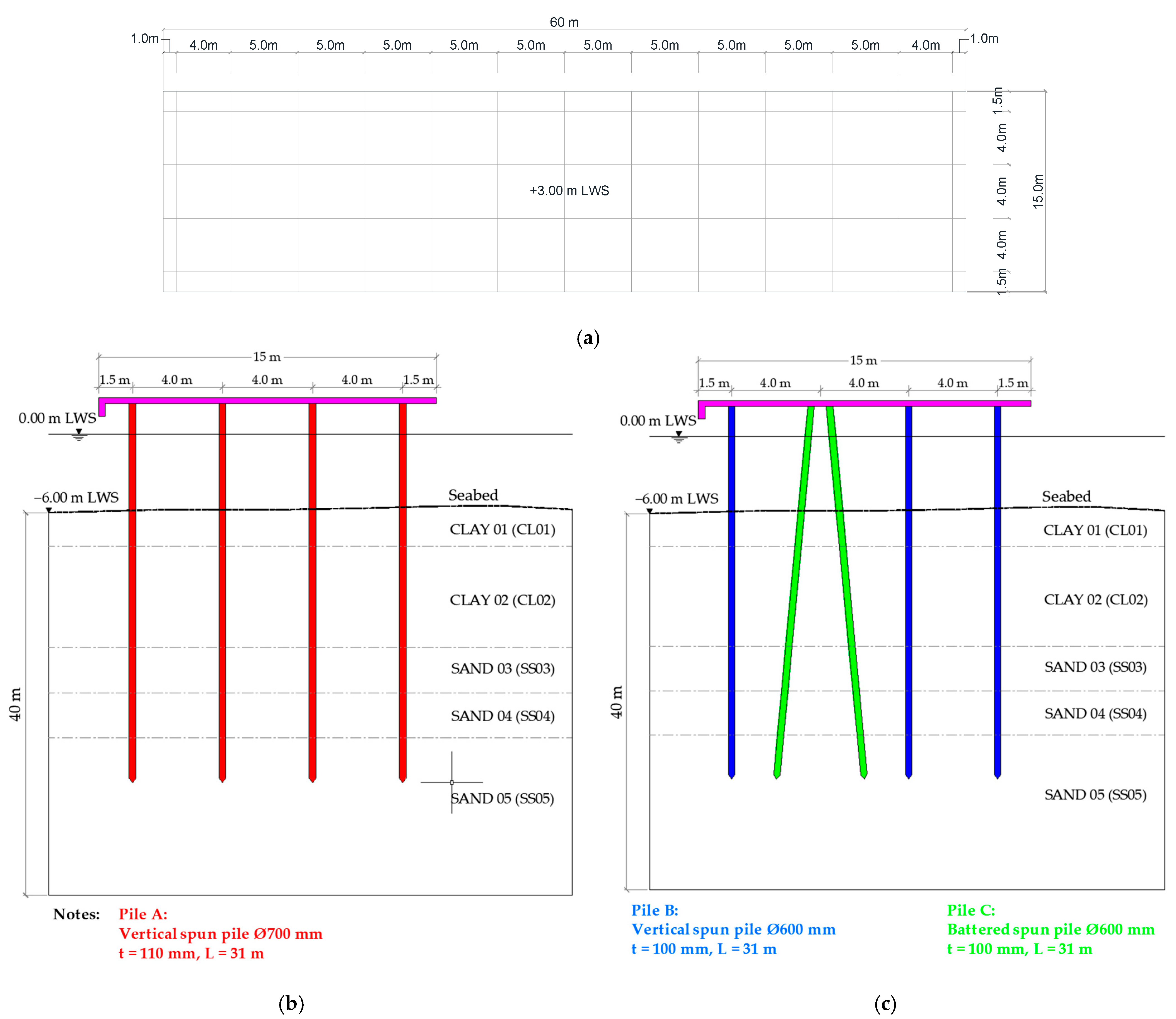
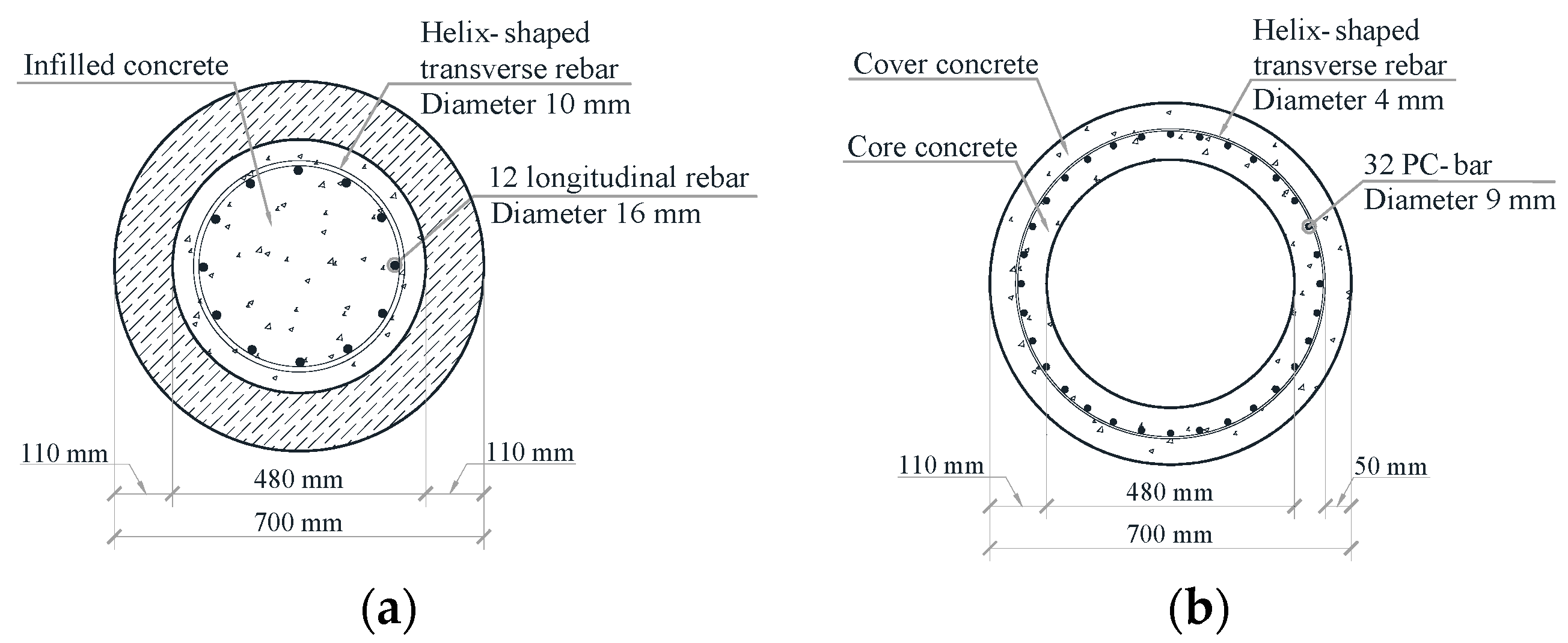
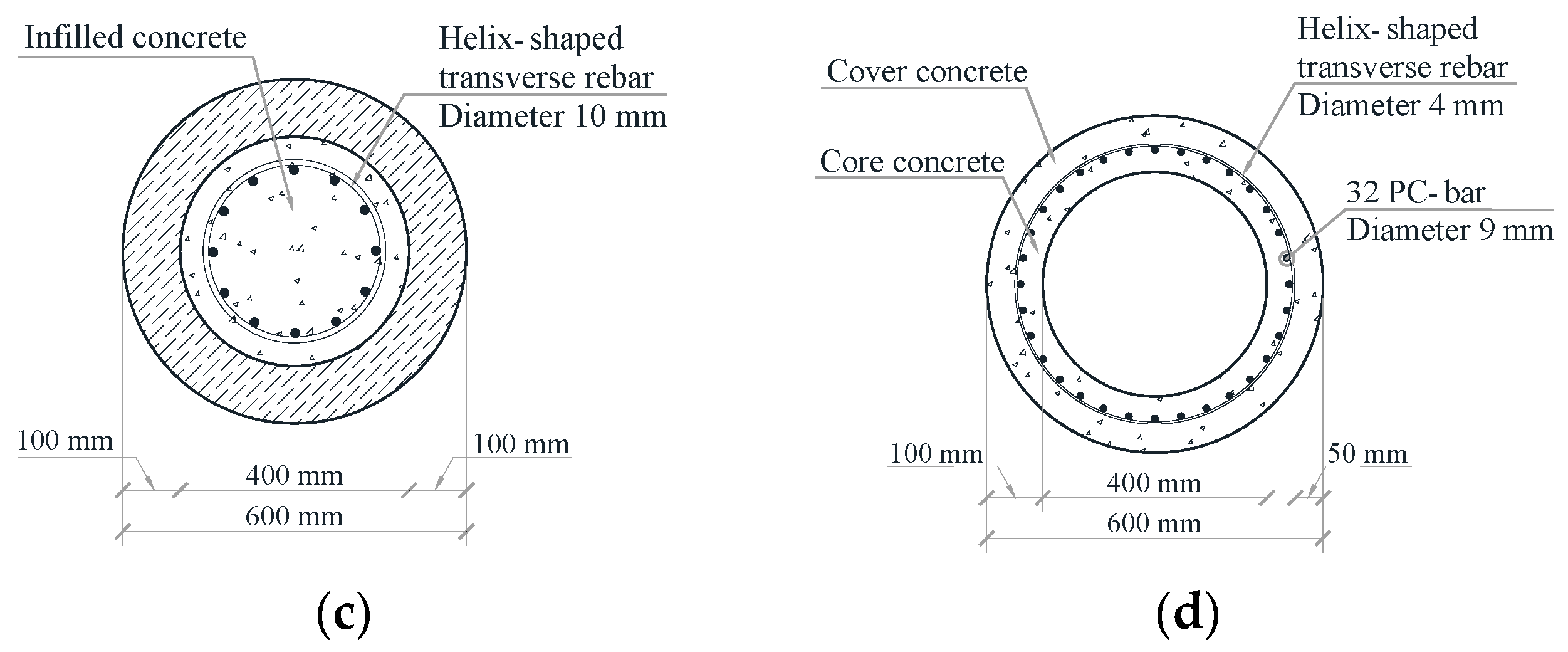

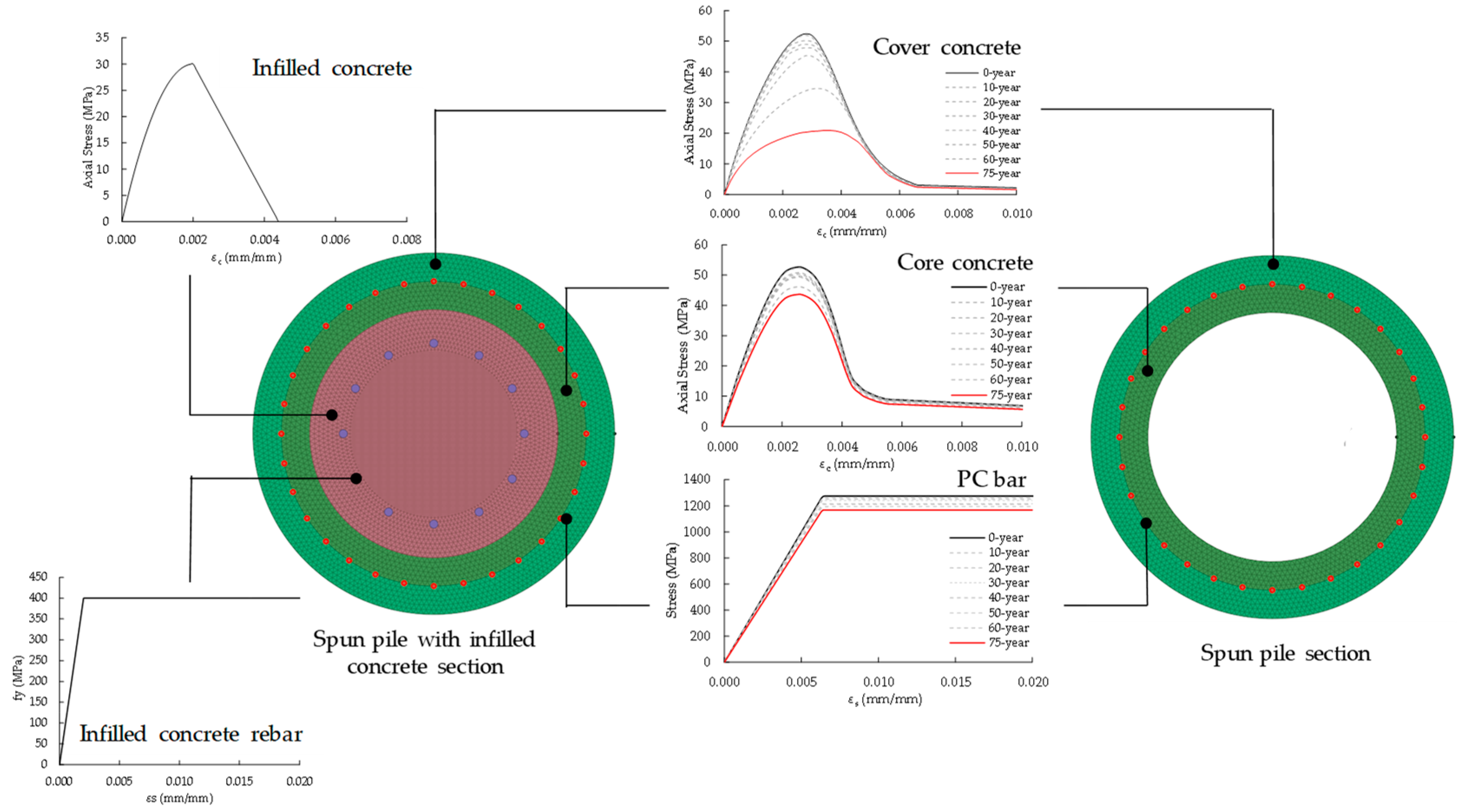
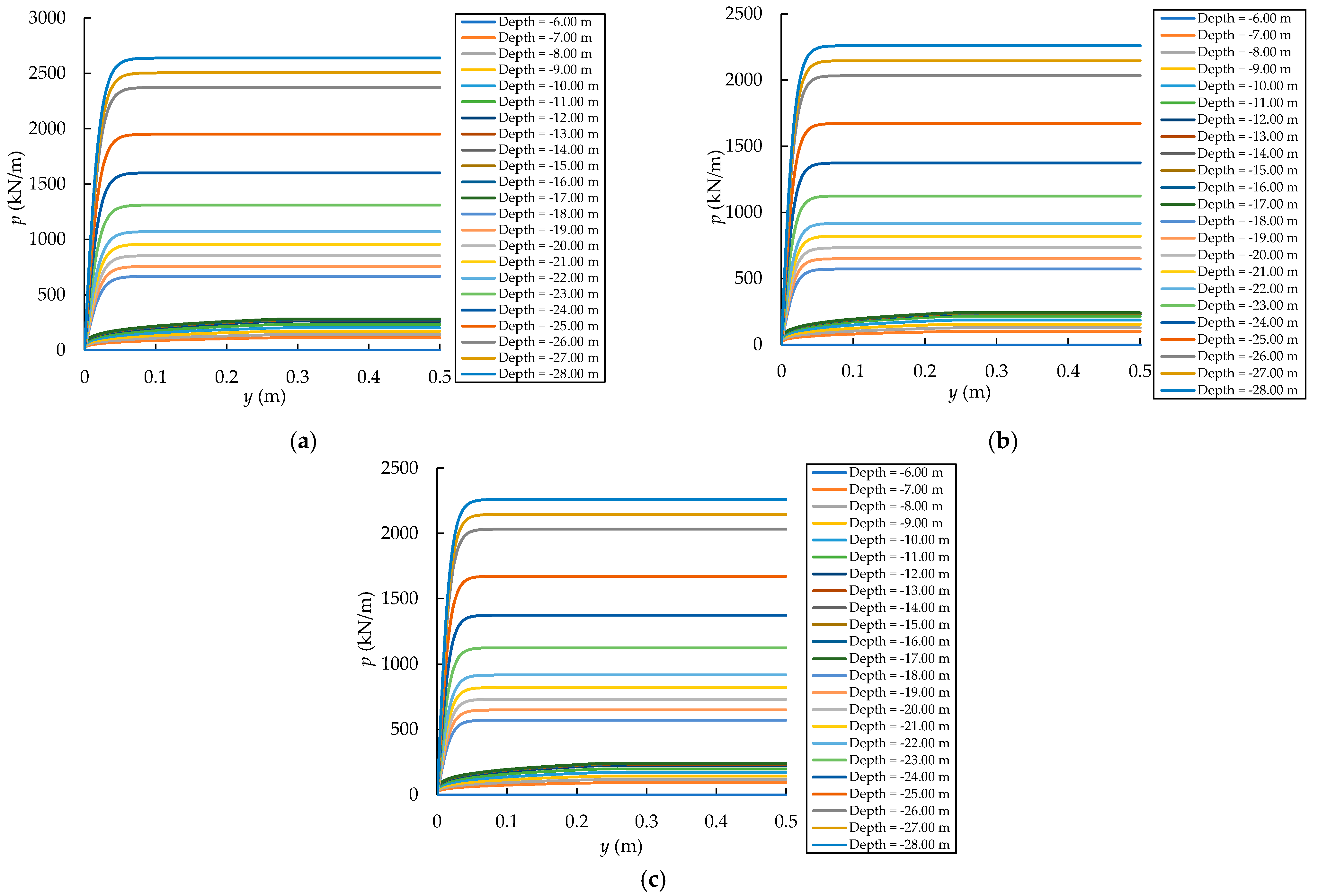
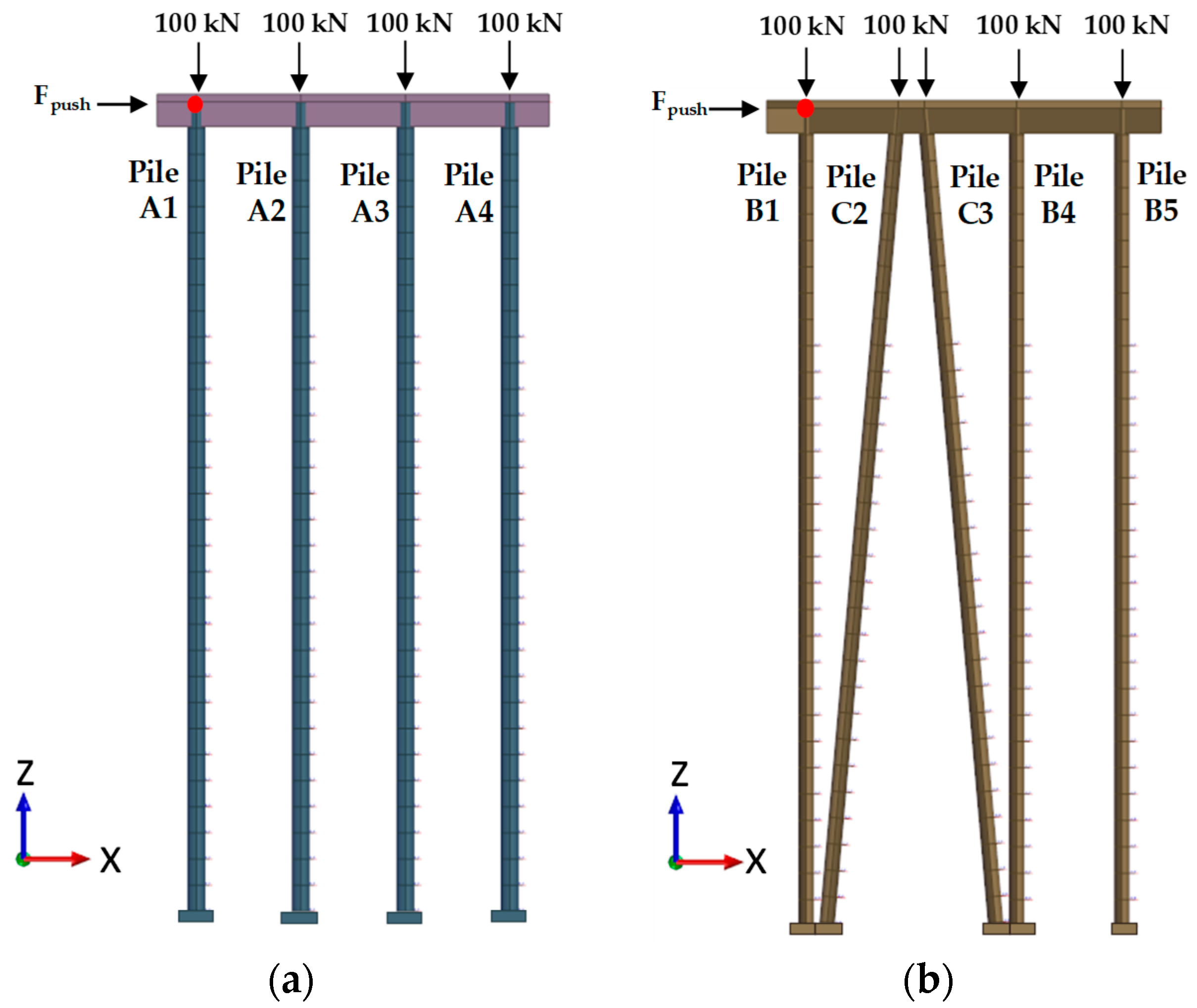

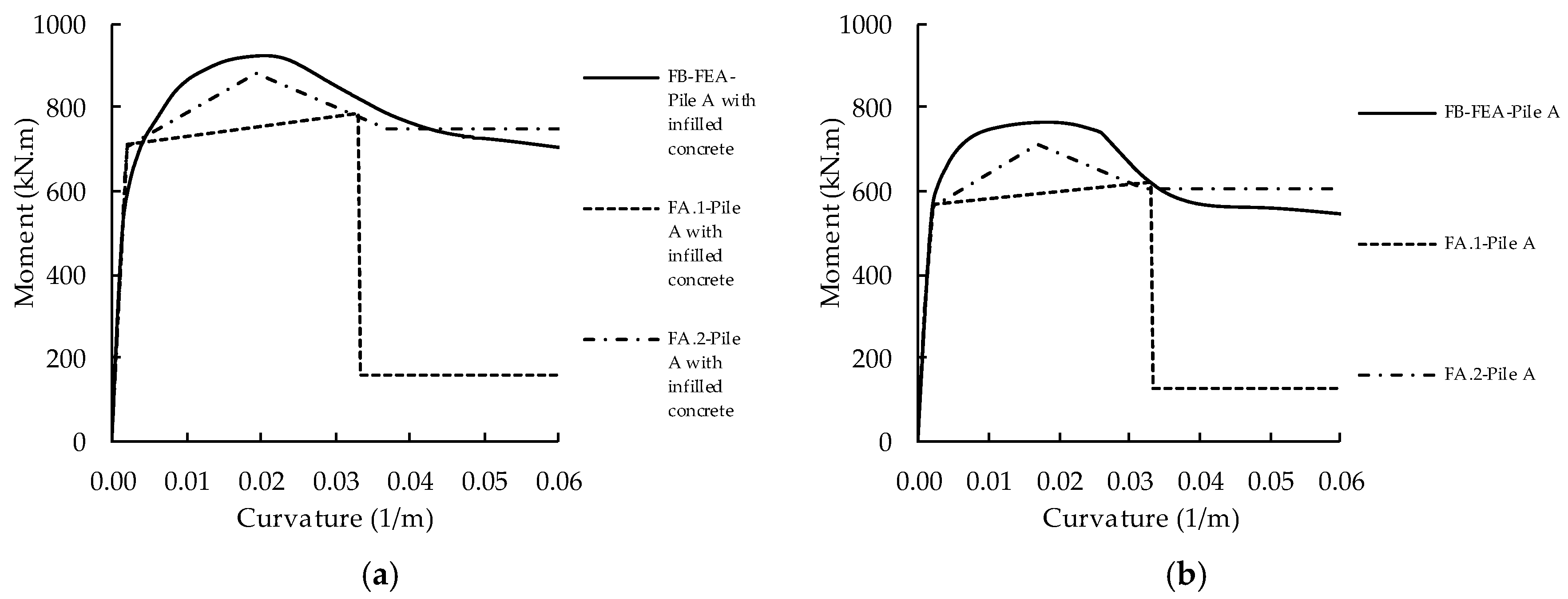
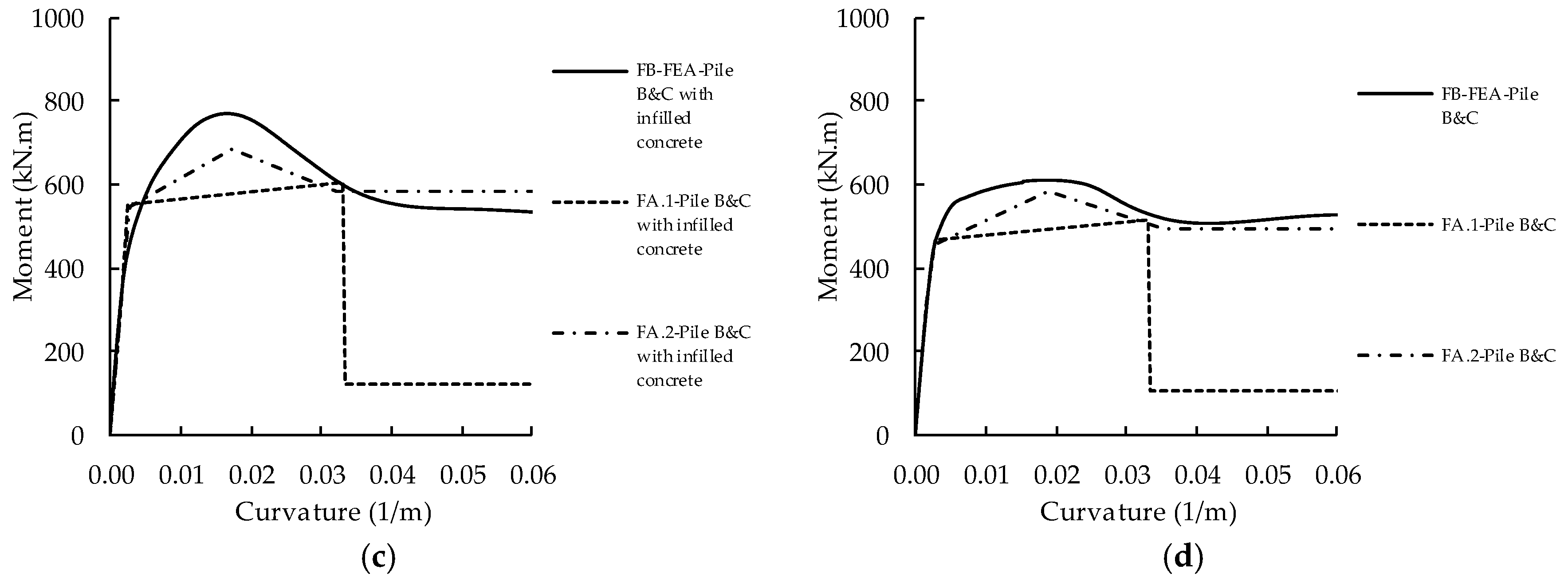
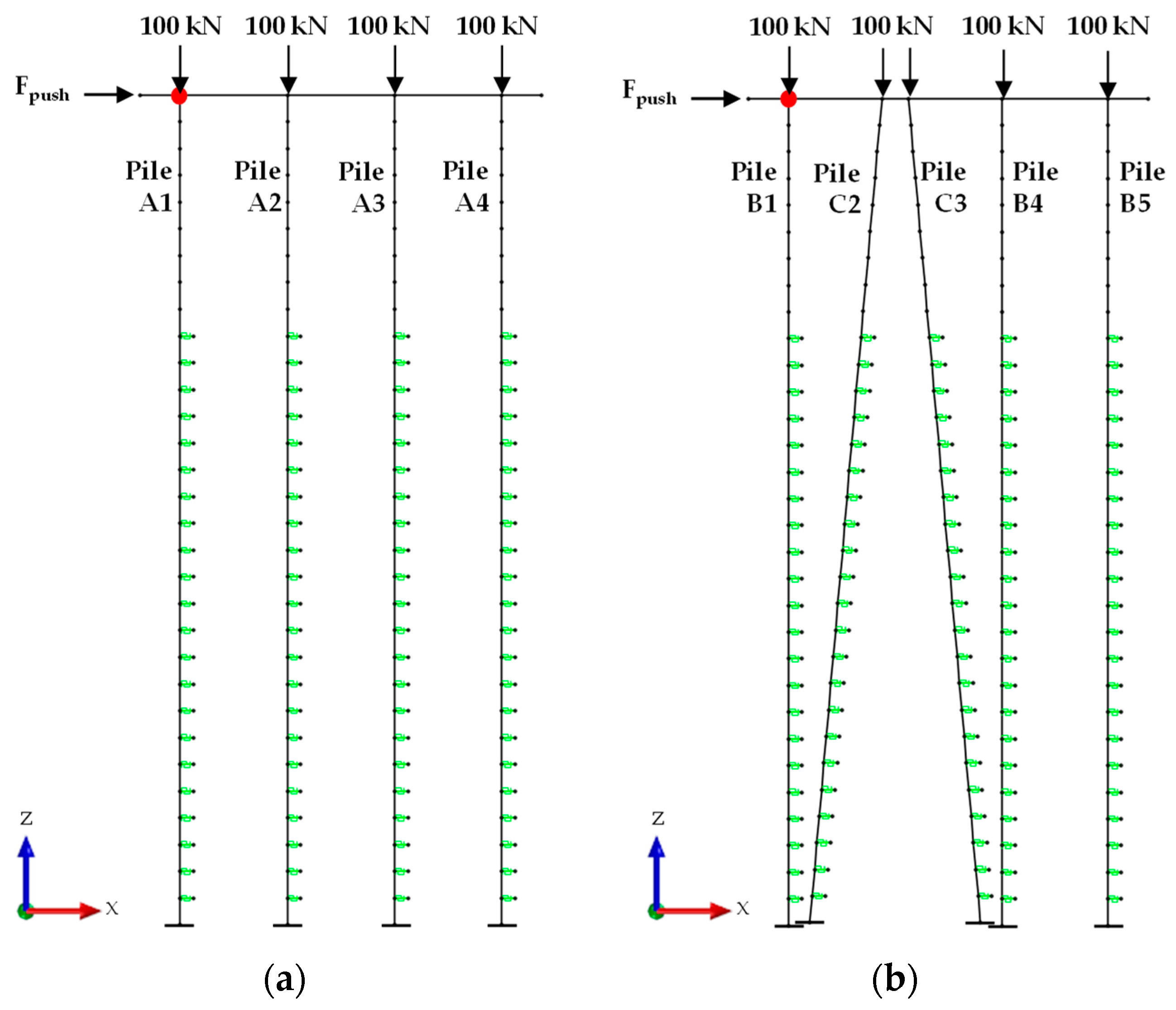
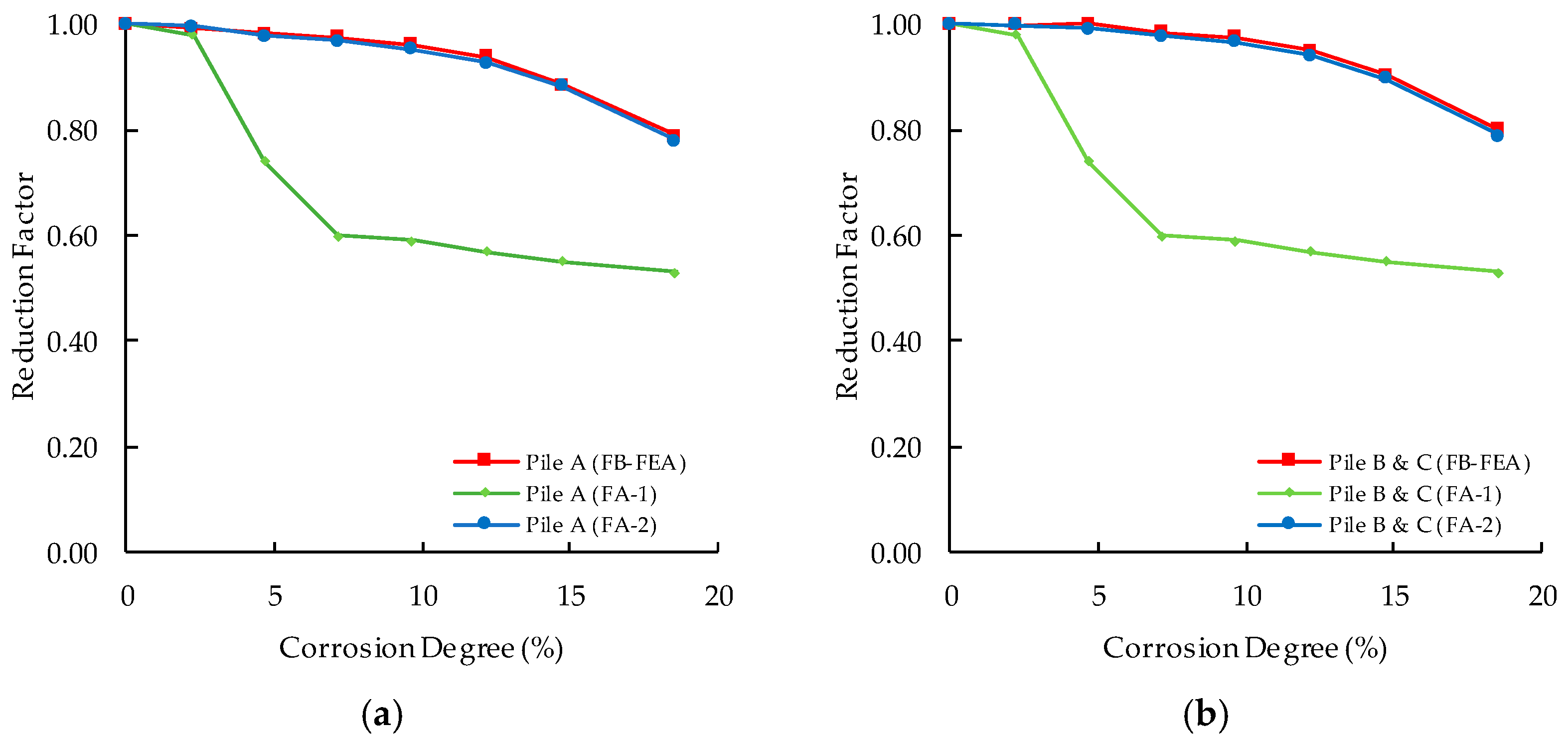
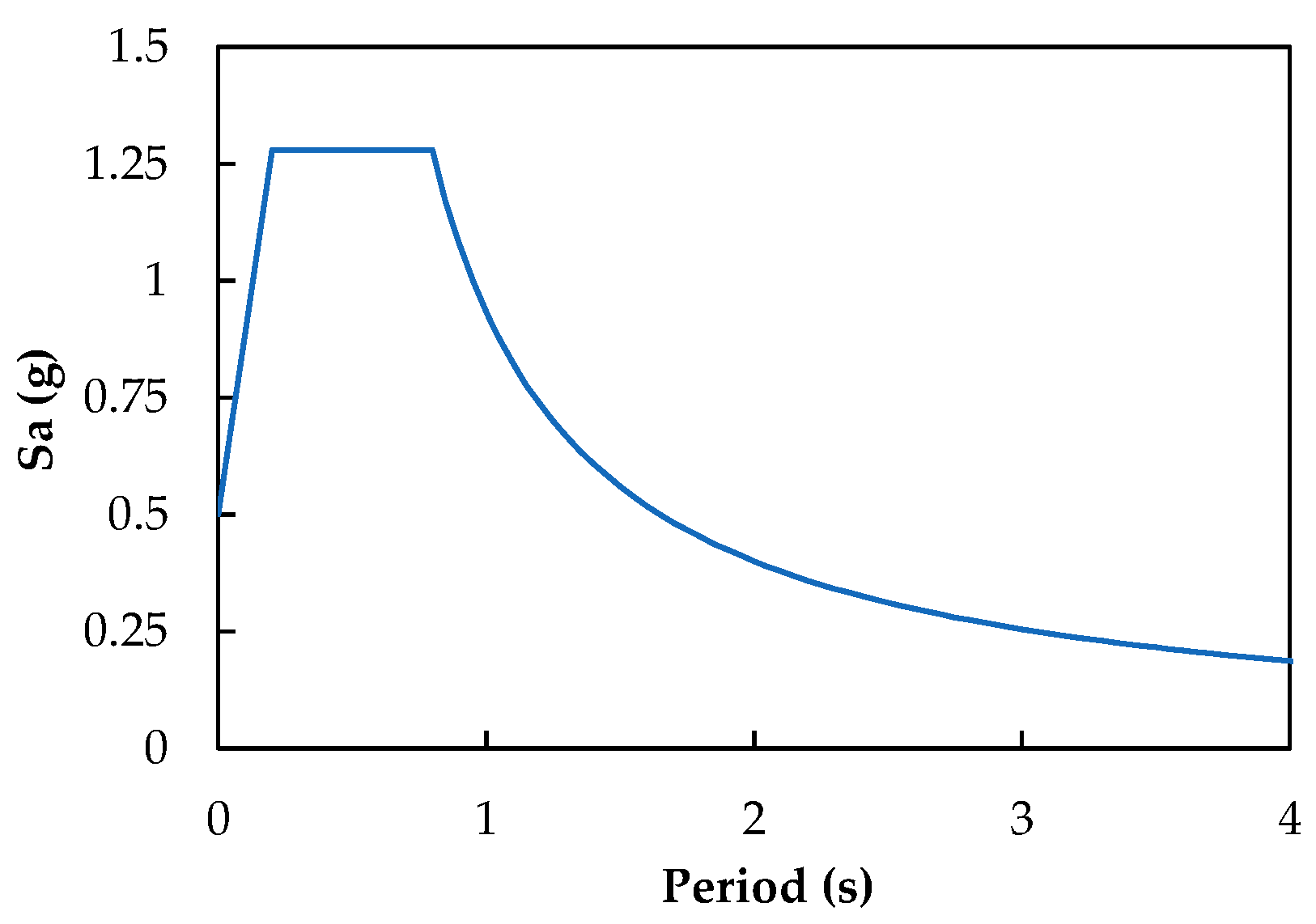
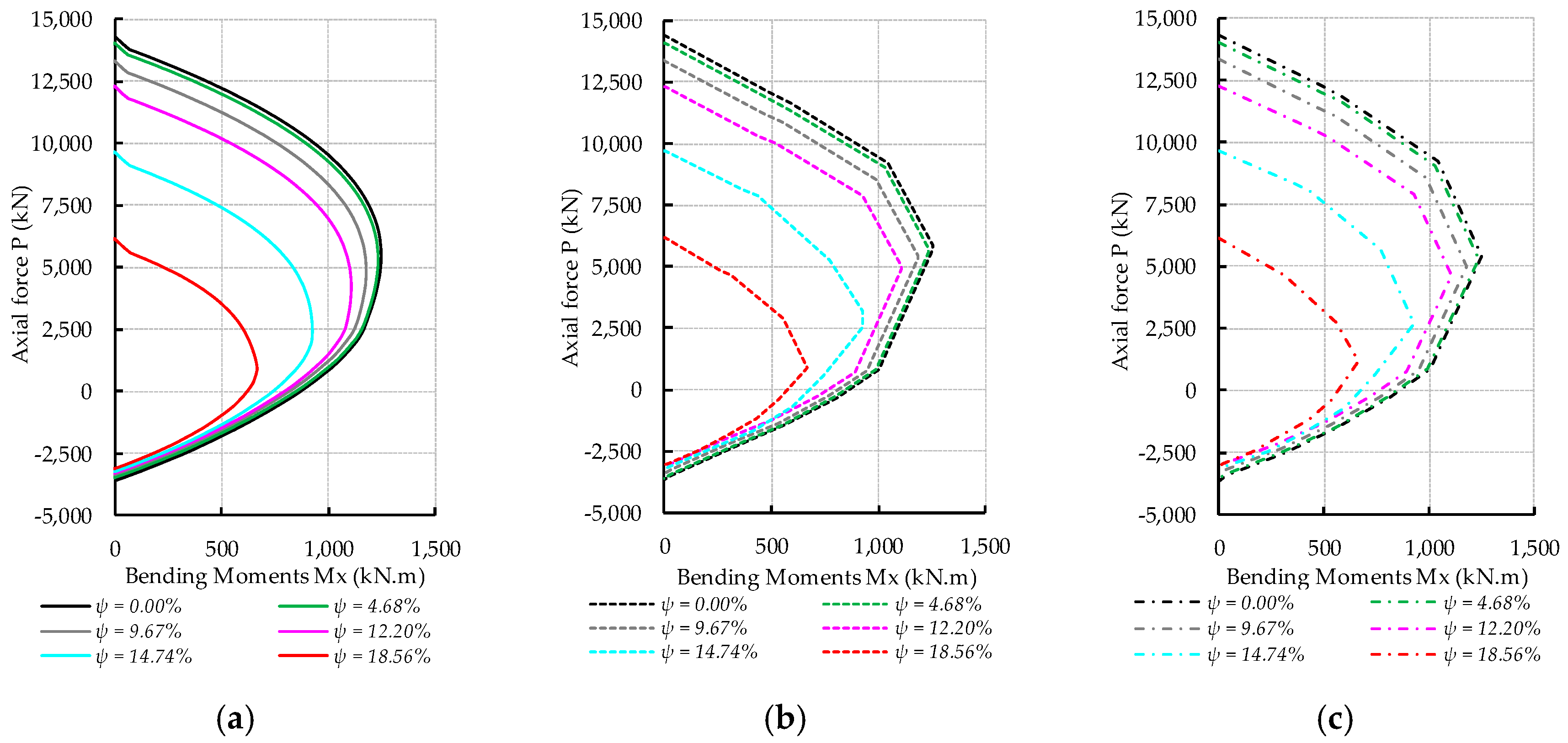

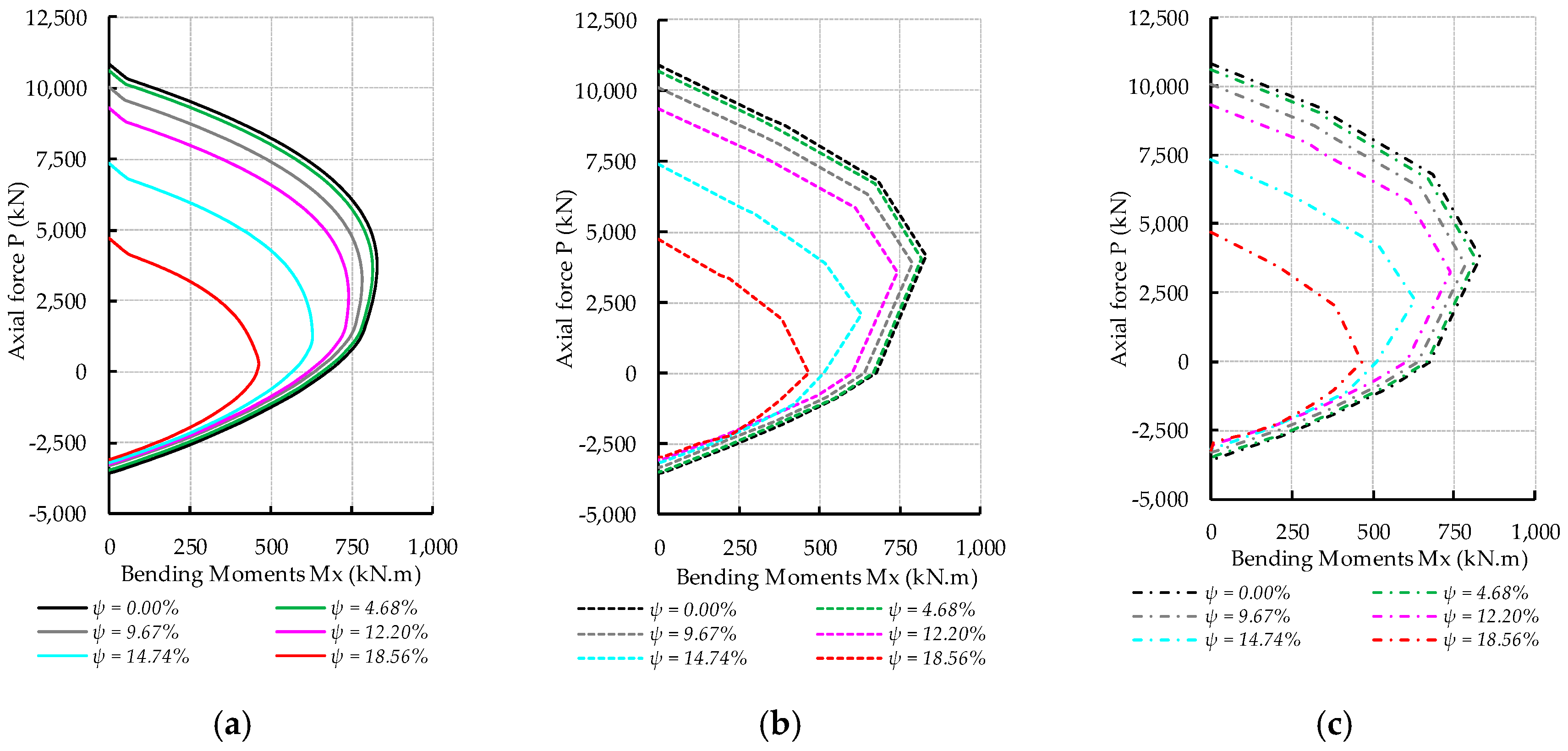
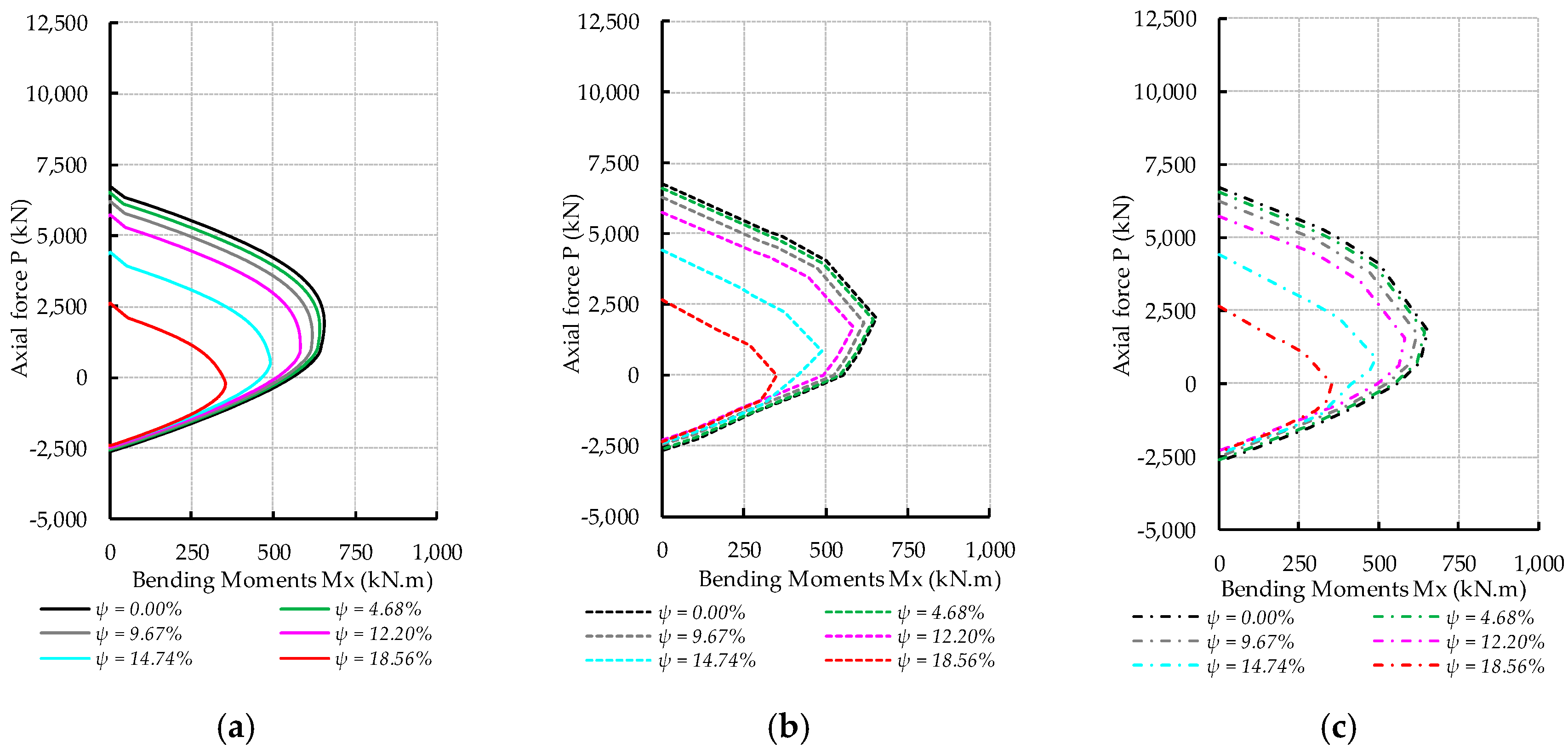




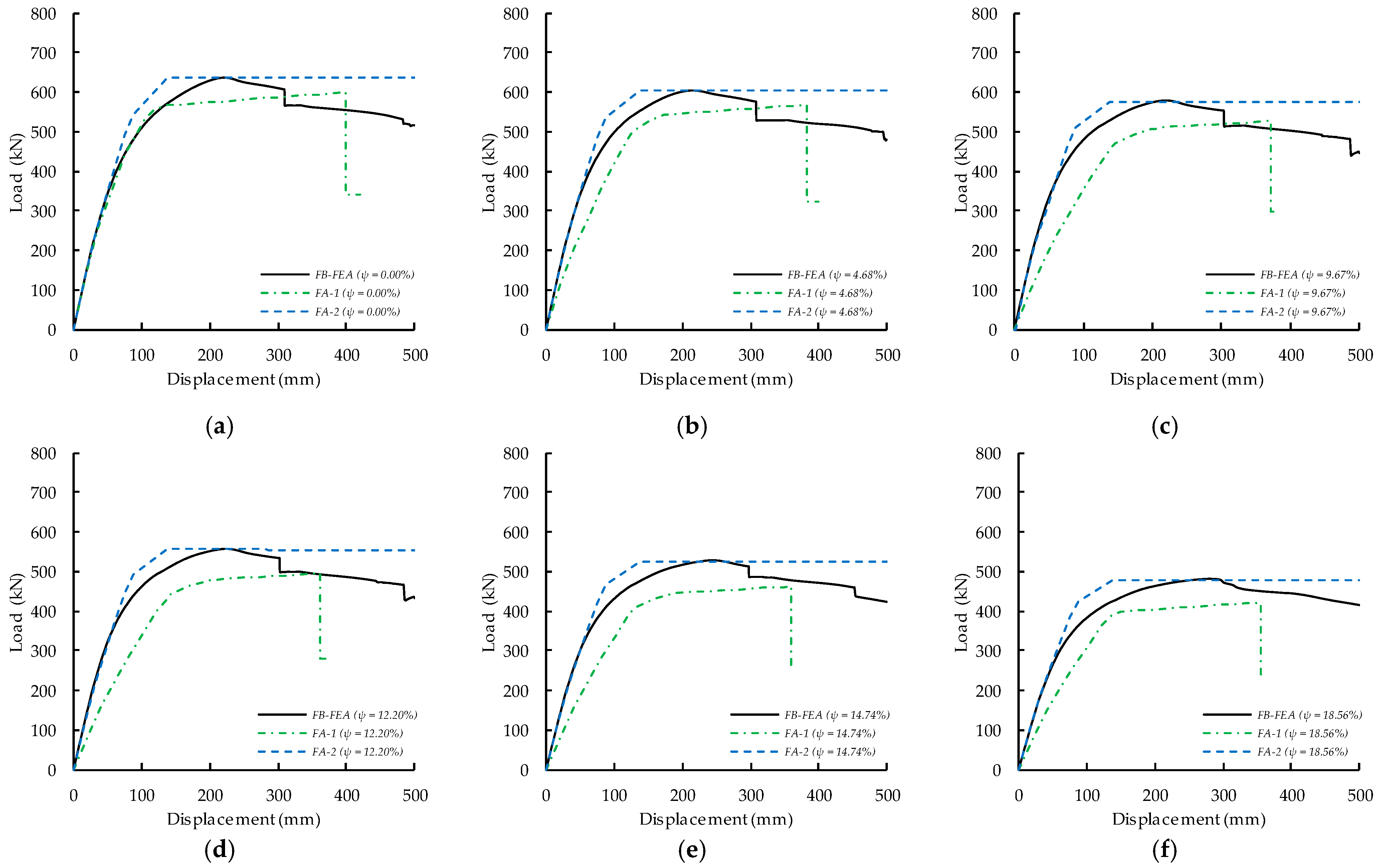
| Material Properties | ||
|---|---|---|
| fco | Cover concrete compressive strength (MPa) | 52 |
| εco | Strain at cover concrete peak strength | 0.00275 |
| fcc | Core concrete compressive strength (MPa) | 53.95 |
| εcc | Strain at core concrete peak strength | 0.00323 |
| fc | Deck and infilled concrete compressive strength (MPa) | 30 |
| εc | Strain at deck and infilled concrete peak strength | 0.00275 |
| fy-pc | PC bar yield strength (MPa) | 1275 |
| fu-pc | PC bar ultimate strength (MPa) | 1420 |
| Es | PC bar elastic modulus (MPa) | 190,000 |
| σini | PC bar initial stress (MPa) | 781 |
| fy-in | Infilled concrete rebar yield strength (MPa) | 400 |
| fu-in | Infilled concrete rebar ultimate strength (MPa) | 620 |
| Ein | Infilled concrete rebar elastic modulus (MPa) | 200,000 |
| Layer Code | N-SPT | Layer Thickness (m) | Soil Type | Specific Gravity (GS) | Water Content Wn (%) | Unit Weight γn (kN/m3) | Liquid Limit LL (%) | Plastic Limit PL (%) | Friction Angle ϕ (°) | Cohesion c (kN/m2) | Shear Wave Velocity Vs (m/s) |
|---|---|---|---|---|---|---|---|---|---|---|---|
| CL01 | 2–4 | 3 | Very Soft Clay | 2.614 | 61.24 | 10.07 | 78.75 | 35.28 | 6 | 41.19 | 125.99 |
| CL02 | 5–6 | 9 | Soft Clay | 2.623 | 57.68 | 10.33 | 76.24 | 34.14 | 7 | 42.22 | 170.48 |
| SS03 | 11–19 | 4 | Silty Sand | 2.656 | 46.2 | 10.75 | - | - | 22 | - | 217.94 |
| SS04 | 28–33 | 4 | Medium Sand | 2.663 | 15.72 | 11.09 | - | - | 30 | - | 249.76 |
| SS05 | 35–60 | 20 | Dense Sand | 2.661 | 14.36 | 11.89 | - | - | 34 | - | 285.47 |
| Point | Pile A with Infilled Concrete | Pile A | Pile B&C with Infilled Concrete | Pile B&C | ||||||||
|---|---|---|---|---|---|---|---|---|---|---|---|---|
| Bending Moment | M/My | ϕ | Bending Moment | M/My | ϕ | Bending Moment | M/My | ϕ | Bending Moment | M/My | ϕ | |
| (kN·m) | (rad) | (kN·m) | (rad) | (kN·m) | (rad) | (kN·m) | (rad) | |||||
| I | 0.00 | 0.00 | 0.0000 | 0.00 | 0.00 | 0.0000 | 0.00 | 0.00 | 0.0000 | 0.00 | 0.00 | 0.0000 |
| II | 712.01 | 1.00 | 0.0014 | 566.00 | 1.00 | 0.0015 | 552.17 | 1.00 | 0.0016 | 468.96 | 1.00 | 0.0017 |
| III | 783.21 | 1.10 | 0.0330 | 622.59 | 1.10 | 0.0330 | 607.39 | 1.10 | 0.0330 | 515.85 | 1.10 | 0.0330 |
| IV | 156.64 | 0.20 | 0.0333 | 124.52 | 0.22 | 0.0333 | 121.48 | 0.22 | 0.0333 | 103.17 | 0.23 | 0.0333 |
| V | 156.64 | 0.20 | 0.0535 | 124.52 | 0.22 | 0.0535 | 121.48 | 0.22 | 0.0535 | 103.17 | 0.23 | 0.0535 |
| Point | Pile A with Infilled Concrete | Pile A | Pile B&C with Infilled Concrete | Pile B&C | ||||||||
|---|---|---|---|---|---|---|---|---|---|---|---|---|
| Bending Moment | M/My | ϕ | Bending Moment | M/My | ϕ | Bending Moment | M/My | ϕ | Bending Moment | M/My | ϕ | |
| (kN·m) | (rad) | (kN·m) | (rad) | (kN·m) | (rad) | (kN·m) | (rad) | |||||
| I | 0.00 | 0.00 | 0.0000 | 0.00 | 0.00 | 0.0000 | 0.00 | 0.00 | 0.0000 | 0.00 | 0.00 | 0.0000 |
| II | 706.36 | 1.00 | 0.0013 | 560.39 | 1.00 | 0.0013 | 547.79 | 1.00 | 0.0014 | 457.80 | 1.00 | 0.0015 |
| III | 882.95 | 1.25 | 0.0136 | 711.70 | 1.27 | 0.0119 | 684.74 | 1.25 | 0.0103 | 581.41 | 1.27 | 0.0114 |
| IV | 750.51 | 1.06 | 0.0258 | 604.94 | 1.08 | 0.0225 | 582.03 | 1.06 | 0.0192 | 494.20 | 1.08 | 0.0212 |
| V | 750.51 | 1.06 | 0.0613 | 604.94 | 1.08 | 0.0613 | 582.03 | 1.06 | 0.0613 | 494.20 | 1.08 | 0.0613 |
| Pile | Corrosion Degree | Rust Thickness of PC Bar, di (mm) | FB-FEA | FA-1 | FA-2 |
|---|---|---|---|---|---|
| η | η | ηsp | |||
| Pile A | 0.00% | 0.000 | 1.000 | 1.000 | 1.000 |
| 4.68% | 0.197 | 0.982 | 0.740 | 0.977 | |
| 9.67% | 0.497 | 0.960 | 0.590 | 0.951 | |
| 12.20% | 0.669 | 0.938 | 0.570 | 0.927 | |
| 14.74% | 0.852 | 0.885 | 0.550 | 0.882 | |
| 18.56% | 1.144 | 0.789 | 0.530 | 0.778 | |
| Piles B and C | 0.00% | 0.000 | 1.000 | 1.000 | 1.000 |
| 4.68% | 0.197 | 0.999 | 0.740 | 0.990 | |
| 9.67% | 0.497 | 0.974 | 0.590 | 0.964 | |
| 12.20% | 0.669 | 0.950 | 0.570 | 0.939 | |
| 14.74% | 0.852 | 0.902 | 0.550 | 0.897 | |
| 18.56% | 1.144 | 0.799 | 0.530 | 0.788 |
| Exposure Time (Years) | Corrosion Degree | PSW-A | PSW-B | ||||
|---|---|---|---|---|---|---|---|
| Natural Period (s) | Natural Period (s) | ||||||
| FB-FEA | FA-1 | FA-2 | FB-FEA | FA-1 | FA-2 | ||
| 0 | 0.00% | 1.3915 | 1.3916 | 1.3916 | 1.4019 | 1.4018 | 1.4018 |
| 20 | 4.68% | 1.3938 | 1.5356 | 1.3964 | 1.4061 | 1.5001 | 1.4087 |
| 40 | 9.67% | 1.4143 | 1.6323 | 1.4161 | 1.4242 | 1.5818 | 1.4260 |
| 50 | 12.20% | 1.4211 | 1.6479 | 1.4229 | 1.4476 | 1.5960 | 1.4508 |
| 60 | 14.74% | 1.4772 | 1.6643 | 1.4744 | 1.4815 | 1.6085 | 1.4853 |
| 75 | 18.56% | 1.5852 | 1.6813 | 1.5854 | 1.6021 | 1.6240 | 1.6077 |
| Corrosion Degree | PSW-A | PSW-B | ||||||
|---|---|---|---|---|---|---|---|---|
| Total Mass (kN) | Fi (kN) | Total Mass (kN) | Fi (kN) | |||||
| FB-FEA | FA-1 | FA-2 | FB-FEA | FA-1 | FA-2 | |||
| 0.00% | 1742.92 | 1068.82 | 1068.68 | 1068.68 | 1816.60 | 1103.98 | 1104.03 | 1104.03 |
| 4.68% | 1066.64 | 949.01 | 1064.25 | 1099.92 | 1017.21 | 1097.46 | ||
| 9.67% | 1047.89 | 882.62 | 1046.30 | 1082.96 | 954.78 | 1081.32 | ||
| 12.20% | 1041.78 | 872.79 | 1040.21 | 1061.84 | 944.78 | 1058.97 | ||
| 14.74% | 994.14 | 862.68 | 996.41 | 1032.59 | 936.03 | 1029.41 | ||
| 18.56% | 913.77 | 852.43 | 913.62 | 940.50 | 925.47 | 936.56 | ||
| Pile | Maximum Compression Force (kN) | Maximum Tension Force (kN) | Maximum Bending Moment (kN·m) |
|---|---|---|---|
| Pile A with infilled concrete | |||
| FB-FEA | 14,303.91 | 3560.68 | 1250.46 |
| FA-1 | 14,378.36 | 3663.61 | 1252.96 |
| FA-2 | 14,321.07 | 3649.01 | 1251.96 |
| Pile A | |||
| FB-FEA | 8699.67 | 2595.58 | 961.01 |
| FA-1 | 8755.84 | 2587.32 | 962.84 |
| FA-2 | 8712.28 | 2578.05 | 962.07 |
| Piles B and C with infilled concrete | |||
| FB-FEA | 10,820.78 | 3560.68 | 826.93 |
| FA-1 | 10,878.31 | 3580.29 | 828.67 |
| FA-2 | 10,834.97 | 3564.92 | 828.00 |
| Piles B and C | |||
| FB-FEA | 6713.32 | 2595.58 | 654.86 |
| FA-1 | 6754.47 | 2691.66 | 655.46 |
| FA-2 | 6720.86 | 2678.26 | 654.94 |
| Pile | Corrosion Degree (%) | Maximum Compression Force (kN) | Maximum Tension Force (kN) | Maximum Bending Moment (kN·m) |
|---|---|---|---|---|
| Pile A with infilled concrete | 0.00% | 14,303.91 | 3560.68 | 1250.46 |
| 4.68% | 14,027.56 | 3453.43 | 1231.68 | |
| 9.67% | 13,307.74 | 3332.61 | 1179.88 | |
| 12.20% | 12,273.77 | 3267.17 | 1106.59 | |
| 14.74% | 9667.49 | 3198.31 | 924.13 | |
| 18.56% | 6157.75 | 3088.70 | 664.42 | |
| Pile A | 0.00% | 8699.67 | 2595.58 | 961.01 |
| 4.68% | 8565.06 | 2546.50 | 946.71 | |
| 9.67% | 8142.48 | 2491.21 | 907.45 | |
| 12.20% | 7486.24 | 2461.27 | 849.57 | |
| 14.74% | 7338.26 | 2429.75 | 703.83 | |
| 18.56% | 3501.19 | 2379.59 | 495.68 | |
| Piles B and C with infilled concrete | 0.00% | 10,820.78 | 3560.68 | 826.93 |
| 4.68% | 10,607.30 | 3453.43 | 815.47 | |
| 9.67% | 10,062.26 | 3332.61 | 784.35 | |
| 12.20% | 9286.79 | 3267.17 | 739.43 | |
| 14.74% | 7338.26 | 3198.31 | 628.43 | |
| 18.56% | 4710.83 | 3088.70 | 464.74 | |
| Piles B and C | 0.00% | 6713.32 | 2595.58 | 654.86 |
| 4.68% | 6533.56 | 2546.50 | 643.04 | |
| 9.67% | 6214.06 | 2491.21 | 618.25 | |
| 12.20% | 5709.99 | 2461.27 | 582.04 | |
| 14.74% | 4397.51 | 2429.75 | 489.03 | |
| 18.56% | 2628.92 | 2379.59 | 352.00 |
| Corrosion Degree | PSW-A | PSW-B | ||||
|---|---|---|---|---|---|---|
| Load Capacity (kN) | Load Capacity (kN) | |||||
| FB-FEA | FA-1 | FA-2 | FB-FEA | FA-1 | FA-2 | |
| 0.00% | 689.05 | 635.97 | 687.75 | 635.20 | 600.31 | 636.32 |
| 4.68% | 666.18 | 606.85 | 664.87 | 605.74 | 568.39 | 604.63 |
| 9.67% | 632.89 | 562.82 | 630.84 | 578.03 | 527.21 | 576.32 |
| 12.20% | 611.74 | 542.64 | 609.76 | 557.93 | 495.52 | 555.87 |
| 14.74% | 579.56 | 513.07 | 577.69 | 527.06 | 462.89 | 525.13 |
| 18.56% | 537.06 | 469.08 | 535.36 | 481.14 | 422.01 | 479.02 |
Disclaimer/Publisher’s Note: The statements, opinions and data contained in all publications are solely those of the individual author(s) and contributor(s) and not of MDPI and/or the editor(s). MDPI and/or the editor(s) disclaim responsibility for any injury to people or property resulting from any ideas, methods, instructions or products referred to in the content. |
© 2023 by the authors. Licensee MDPI, Basel, Switzerland. This article is an open access article distributed under the terms and conditions of the Creative Commons Attribution (CC BY) license (https://creativecommons.org/licenses/by/4.0/).
Share and Cite
Refani, A.N.; Nagao, T. Simplified Method for Nonlinear Seismic Response Analysis of Corroded Pile-Supported Wharf. Appl. Sci. 2023, 13, 10936. https://doi.org/10.3390/app131910936
Refani AN, Nagao T. Simplified Method for Nonlinear Seismic Response Analysis of Corroded Pile-Supported Wharf. Applied Sciences. 2023; 13(19):10936. https://doi.org/10.3390/app131910936
Chicago/Turabian StyleRefani, Afif Navir, and Takashi Nagao. 2023. "Simplified Method for Nonlinear Seismic Response Analysis of Corroded Pile-Supported Wharf" Applied Sciences 13, no. 19: 10936. https://doi.org/10.3390/app131910936





